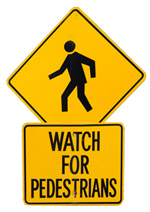
NHTSA report tracks pedestrian death and injury, offers safety tips
We are all pedestrians, at one time or another. The National Highway Traffic Safety Administration (NHTSA) recently reported that 4,743 pedestrians were killed and an estimated 76,000 injured in traffic crashes in the United States during 2012.
On average, a pedestrian was killed every two hours and injured every seven minutes in traffic crashes that year. The NHTSA report helps illustrate who may be most at risk of becoming a pedestrian fatality.
report helps illustrate who may be most at risk of becoming a pedestrian fatality.
In 2012, nearly three-fourths (73 percent) of pedestrian fatalities occurred in urban settings rather than rural settings. More than two-thirds (70 percent) of pedestrian fatalities occurred at non-intersections rather than intersections.
Eighty-nine percent of pedestrian fatalities occurred during normal weather conditions (clear/cloudy), compared to rain snow and foggy conditions. A majority of the pedestrian fatalities, 70 percent, occurred during the nighttime (6 p.m. – 5:59 a.m.).
People older than age 65 accounted for 20 percent of all pedestrian fatalities and an estimated nine percent of all pedestrians injured in 2012. More than one-fifth of children, ages 5 to 15, that were killed in traffic crashes were pedestrians.
More than two-thirds (69 percent) of pedestrians killed were male. That was more than double the rate for females. Nearly one-third of all pedestrian fatalities occurred in crashes between 8 p.m. and 11:59 p.m.
Alcohol impairment – either for the driver or for the pedestrian – was reported in nearly half (48 percent) of the traffic crashes that resulted in pedestrian fatalities. One-third of those pedestrians involved in fatal crashes had a blood alcohol concentration of .08 or higher. Pedestrians, ages 45-54, who were killed had the highest percentage of alcohol impairment at 49 percent.
Nine out of 10 pedestrian fatalities involved a single vehicle and nearly one-fifth of the pedestrians killed in 2012 were involved in hit-an-run crashes.
NHTSA offers safety tips for both pedestrians and drivers.
For pedestrians:
-
Walk on a sidewalk or path whenever one is available.
-
If no sidewalk or path is available, walk facing traffic (the left side of the road) as far away from traffic as possible. Avoid all distractions that take your eyes (and ears) off the road environment.
-
Be cautious, night and day, when sharing the road with vehicles. Never assume that you are seen and try to make eye contact with drivers as they approach you.
-
Be predictable. Cross streets at crosswalks and intersections whenever possible. This is where drivers expect pedestrians.
-
If a crosswalk or intersection is not available, locate a well-lit area and wait for a gap in traffic that allows time to cross safely. Keep watching for traffic while crossing.
-
Stay off of freeways, restricted-access highways and other pedestrian-prohibited roadways.
-
Be visible at all times. Wear bright clothing during the day, and wear reflective materials or use a flashlight at night.
-
Avoid alcohol and drugs when walking; they impair abilities and judgment.
For drivers:
-
Watch for pedestrians everywhere, at all times. Pedestrians are often not walking where they should be.
-
Be especially vigilant for pedestrians in hard-to-see conditions, such as nighttime or in bad weather.
-
Slow down and be prepared to stop when turning or otherwise entering a crosswalk.
-
Always stop for pedestrians in crosswalks, and stop far enough back so other vehicles may see and stop for pedestrians crossing too.
-
Never pass vehicles stopped at a crosswalk. They are stopped to allow pedestrians to cross the street.
-
Never drive impaired by alcohol and/or drugs.
-
Follow the speed limit, especially around pedestrians.
-
Follow slower speed limits in school zones and in neighborhoods where children are present.
Published 03-06-15